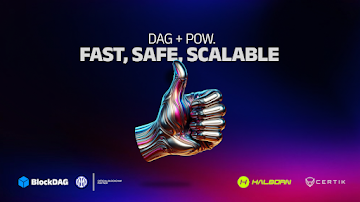BlockDAG’s Upcoming Sponsorship, Chainlink’s Hesitant Breakout, and Litecoin’s Flat Growth: Best Long Term Cryptos
As of this week, BlockDAG is priced at just $0.0016, yet has already achieved presale fundraising of over $410 million, with 26.5 billion BDAG coins sold, 312,000+ holders, and an active user base of 3 million daily miners. All eyes are now on a global sponsorship announcement expected within 2 days, an event that the team says will immediately push prices up.
In contrast, Chainlink is trading near $7.80, and Litecoin has gained a modest 1.8% following its halving. This comparison comes at a pivotal moment, one that could define the best long-term crypto investments for 2025 and beyond.
Let’s break down how each of these three projects currently stacks up: in growth, in relevance, and in ROI potential.
BlockDAG: Scaling Utility Before Price
BlockDAG isn’t waiting for a bull market to prove value. It has shipped over 19,000 miners, rolled out the X1 mobile miner (with over 3 million users daily), and implemented real-time dashboard and explorer tools. The price remains frozen at $0.0016, even as the batch 30 presale price is $0.03, giving early buyers a rare 2900% ROI on paper.
This week is especially important for BlockDAG because of the upcoming global sponsorship reveal. The team has teased that this will surpass their NBA-level teaser, suggesting mainstream visibility is next not months from now, but this week. Unlike projects that overpromise and underdeliver, BlockDAG has hit every milestone on time, raising over $410 million without delays or influencer hype. This credibility shifts it from a speculative asset to a scalable infrastructure play.
What makes it stand out further is its Proof-of-Engagement model via the X1 app, the ongoing buyer battle program, a 25% referral incentive, and the pending Singapore BDAG Deployment Event on October 1. BlockDAG is delivering not just products but network effects. For those researching the best long-term crypto investments, BlockDAG’s metrics and momentum make it a key outlier this week.
Chainlink: Institutional Growth, Retail Hesitation
Chainlink is a household name among oracles and DeFi protocols. Recently, it expanded into the SWIFT pilot program, a strategic move that aims to connect traditional finance with blockchain ecosystems. However, the Chainlink price prediction hasn’t seen short-term validation. The token is hovering around $7.80, largely flat compared to earlier in the year.
Institutional credibility is not translating into buying pressure. Despite SWIFT integration and a robust partnership pipeline, retail traders seem cautious. Volumes have remained steady, but not explosive, and many short-term holders are waiting for LINK to break out of a $6.90–$8.10 resistance range. Until a broader DeFi rebound or major integration with consumer-facing apps unfolds, the Chainlink price prediction continues to be long-term favorable but short-term uncertain. 
Chainlink’s strength remains in its utility layer, but it doesn’t currently offer the kind of asymmetric upside that presale-stage projects like BlockDAG are delivering. For risk-averse portfolios, LINK is still considered one of the best long term crypto investments, but the catalyst moment is clearly elsewhere this week.
Litecoin: Stuck Post-Halving
Litecoin has long been positioned as a “silver to Bitcoin’s gold,” and while it benefited from a 1.8% rise after its halving, the Litecoin price prediction is more muted. On-chain data reveals that volume has declined 5.4% since early September, according to IntoTheBlock Analytics. Halvings typically boost price based on supply shock, but in Litecoin’s case, it didn’t spark a new wave of demand.
There are no new feature upgrades or developer programs in motion, and adoption remains largely confined to mid-tier exchange usage and legacy payment systems. While Litecoin is still widely integrated and considered reliable, it lacks growth vectors that appeal to new buyers. 
In terms of market cap stability and transaction speed, it remains a solid hold, but not a competitive buy for those seeking high ROI or entry into next-gen crypto ecosystems. The Litecoin price prediction remains relatively flat unless paired with broader altcoin momentum or a surprise integration with payment networks.
Why This Week Matters for All Three
While Chainlink and Litecoin hold weight in institutional and legacy investor circles, BlockDAG is the only one with a scheduled visibility catalyst this week. Its $0.0016 entry price, paired with over $410M already raised, makes it uniquely undervalued relative to traction.
For Chainlink, the question is: when will SWIFT and enterprise use cases translate to token demand? For Litecoin, what can spark growth without a roadmap? And for BlockDAG, how long will the $0.0016 opportunity last before the sponsorship reveal unleashes broader media attention?
From a best long term crypto investments standpoint, this week separates scheduled relevance from static reliability. BlockDAG isn’t offering a promise. It’s offering a countdown.
Presale: https://purchase.blockdag.network
Website: https://blockdag.network
Telegram: https://t.me/blockDAGnetworkOfficial
Discord: https://discord.gg/Q7BxghMVyu
Disclaimer: This is a paid post and should not be treated as news/advice. LiveBitcoinNews is not responsible for any loss or damage resulting from the content, products, or services referenced in this press release.
The post BlockDAG’s Upcoming Sponsorship, Chainlink’s Hesitant Breakout, and Litecoin’s Flat Growth: Best Long Term Cryptos appeared first on Live Bitcoin News.
You May Also Like

The final 11 days of the $700 million airdrop: Aster's arbitrage strategies and team strategies explained

A gold statue of Trump with bitcoin in his hands has been erected in the US
